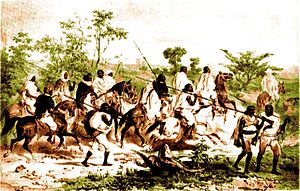User:Devink/Sandbox1
| Ozeros War | |||||||
|---|---|---|---|---|---|---|---|
 Sahb warriors during the Ozeros war | |||||||
| |||||||
| Belligerents | |||||||
The Ozeros War was a seven years long conflict that opposed the Divine Kingdom and their Tuluran allies against the Iifae Imamates and Vardana over the control of Barriset and of the flux of trades circulating through the Ozeros Sea.
Prelude
In 1661, the Yajawil of Barriset was officialy proclaimed after a five years long counter-insurgency against the self-proclaimed Second Caliphate of Barriset. This conflict saw great changes in the region, with Iifae insurgents fleeing the island for Tulura, where they established Imamates on the coast, economically dependent on piracy. This worsened the instability that plagued the region, plagued with feudal conflicts.
At first too busy trying to secure their new place, the Iifae weren't able to plan their reconquest of Barriset. Once they did manage to gain short-term peace with their neighbors, the Imams sent delegations to Vardana and other kingdoms, trying to convince them of the risk the Mutuleses posed to trade and the economy of the region. the Vardanians notably were already concerned by the Mutuleses traders hoarding Ochranese goods, changing the direction of the trade flux represented by the Maritime Jade Road and preventing them from going westward. In 1667, the Artavazd Monarchs entered a secret military alliance with the Imamates against the Mutuleses, made confident by the promises of an upcoming insurection in Barriset that would open them the gates of the island and allow them to push the Mutuleses away from the Ozeros.
Start of the conflict
Since the Second Holy War, sympathy for the Second Caliphate toned down but never entirely left the Iifae population. Imam-priests continued to secretly roam the land, living either in the wild or secretly hosted by sympathizers. They were referred to as "sorcerers" or "witches" by the Mutuleses authorities in opposition to the official Iifae clergy they supported and were publicly sacrificed to Mesfin-Chaak when caught, alongside proven sympathizers or people who attended their illegal ceremonies. This Witch-Hunt limited the capacity of insurgent societies to form, but couldn't destroy them entirely.
It's on these networks that the Imam-Priests relied when organization their "Third Holy War". The support of Vardana guaranteed, they organized their pirate fleets as well as they could through religious fervor. This did not go unoticed from the Ba'atz Yajaw, the Mutulese governor of Barriset, who made his own plans for a preventive "anti-piracy campaign" on the Tuluran Coast. Iifae agents informed the Imam-priests of it, and the latter decided they could not risk waiting any longer for the Monsoon.
Using heavier-than-usual rains as a sign, the Imam-priests announced the beginning of the Third Holy War in the middle of the dry season, before the Mutuleses could start their anti-piracy campaign. Through their spy networks, the Imam-priests alerted the Insurgent societies in Barriset, whom began the long awaited revolt.
The War
Barriset Insurgency
Quickly, many villages entered the Insurgency. The Insurgents had no meaningful supply of weapons nor any organization to speak off beyond following the Imam-priests and other traditional community leaders, but the movement was carried out by a profound religious fervor. They hunted down "Pagans" and "Sympathizers", killing Iifae priests that were part of the official clergy. Sympathizers fled either to the cities, which remained mostly bastions of the Yajawil once the initial attempts at riots were crushed, or to villages and plantations that were loyal to the Divine Kingdom. There, they also organized themselves into militias, where armed slaved and refugees fought side by side under the command of the landowners and local administrators. The backbone of these militias remained the local law-enforcers. Despite all of this, they remained cut off from one another and from the seats of power of the Yajawil by the Insurgents.
From this point onward, the Insurgency divided itself into two large "army" : one moved inland to besiege the plantations, while the second one decided to march on the capital. The Siege of Barriset City was quickly broken when besiegers, tired of waiting for an assault their "officers" knew they were not prepared for, abandoned the siege to pillage the countryside. Sensing their weakness, the B'aatz Yajaw led a sortie against the Iifae, breaking the siege and pushing them deeper inland.
Meanwhile, the pirates made their move. Because the Monsoon was not yet there, they didn't had to pursue trading vessels and moved directly against Barriset' ports where the B'aatz fleet was waiting. Their surprise attack damaged the fleet and the infrastructures, but was ultimately fend off.
Despite the ongoing insurgency, the Mutulese fleet was given the order to move out against the Imamates and the pirate navy. A serie of undecisive naval engagements ended up playing against the Iifae, whom lost control of the Sea after weeks of conflict. They were ultimately pushed back and pursued into their harbors by the Mutuleses.